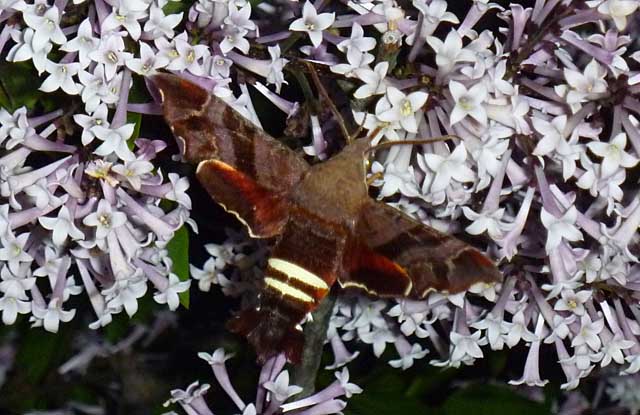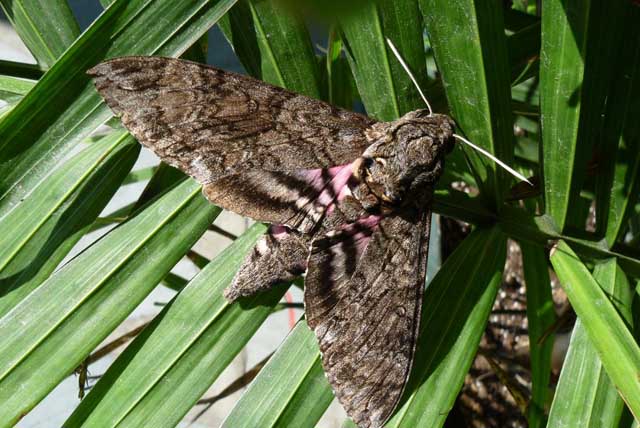
Manduca quinquemaculatus, courtesy of Tim Dyson.
|
|
Updated as per James P. Tuttle's The Hawk Moths of North America, May 20, 2011 Updated as per personal communication with Walt N Tina Davis (Amphion floridensis), May 20, 2011 Updated as per personal communication with Walt N Tina Davis (Agrius cingulata), October 4, 2011 Updated as per BAMONA, October 4, 2011 |

Manduca quinquemaculatus, courtesy of Tim Dyson.
I can also remember seeing Manduca sexta, Manduca quinquemaculatus, Manduca jasminearum, Ceratomia catalpae, Ceratomia amyntor, Ceratomia undulosa, Paonias excaecata, Amorpha juglandis, Eumorpha pandorus, Hemaris thysbe (day flier) and Hyles lineata at lights or along the train tracks (Union County, N.J.) at night nectaring at phlox. The Hemaris species could often be encountered during the day around the butterfly bushes or near the honey suckle vines.
Some of these species I now see at lights on P.E.I.; I have reared most of the local ones.
With so many species from Cape May County common to one or the other or both of my homes, the memories are flooding back!

Amphion floridensis, Stone Harbor, Cape May County, New Jersey,
May 19, 2011, courtesy of Walt N Tina Davis.
A "WO" after the species name indicates that I have no confirmed reports of this species in Cape May County, but I (William Oehlke) expect that this moth is present or might be present.
A "BAMONA" indicates the moth is reported on the BAMONA website and/or in Lepidoptera of North America, #1. Distribution of Silkmoths (Saturniidae) and Hawkmoths (Sphingidae) of Eastern North America, an excellent little booklet available through Paul Opler.
Please help me develop this list with improved, documented accuracy by sending sightings (species, date, location), preferably with an electronic image, via email to Bill Oehlke.
Thanks again to Walt and Tina Davis for the following image of Agrius cingulata, the Pink-spotted Hawkmoth. I do not believe that there are breeding populations in New Jersey. It is more likely a wind assisted stray from further south.

Agrius cingulata, Stone Harbor, Cape May County, New Jersey,
October 4, 2011, courtesy of Walt N Tina Davis
Sphinginae subfamily
Smerinthini Tribe:
Macroglossinae subfamilyDilophonotini tribe:
See Hemaris comparison to help distinguish the next three species.
Philampelini tribe:
Macroglossini tribe:
|
Enjoy some of nature's wonderments, giant silk moth cocoons. These cocoons are for sale winter and fall. Beautiful Saturniidae moths will emerge the following spring and summer. Read Actias luna rearing article. Additional online help available.
Use your browser "Back" button to return to the previous page.
This page is brought to you by Bill Oehlke and the WLSS. Pages are on space rented from Bizland. If you would like to become a "Patron of the Sphingidae Site", contact Bill.
Please send sightings/images to Bill. I will do my best to respond to requests for identification help.
 Show appreciation for this site by clicking on flashing butterfly to the left. The link will take you to a page with links to many insect sites. |
I very much appreciate all the many images that have been sent to me, or of which I have been granted permission to copy and post from other websites. All images on this site remain the property of respective photographers.
If you would like to contribute to the maintenace of this website by sending a contribution to
Bill Oehlke
Box 476
155 Peardon Road
Montague, Prince Edward Island, C0A1R0
Canada
your donation would be much appreciated and would be used for
1) paying for webspace rental;
2) paying for computer maintenance and software upgrades;
3) purchases of additional text reference material (journals and books) in anticipation of expanding the site to a worldwide Sphingidae site;
4) helping to pay my daughter's tuition; with anything left over going to humanitarian aid.
If you are mailing a check from USA, please use $0.85 postage. Donations can also be made through Paypal via the button below.